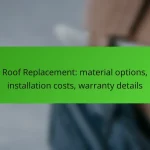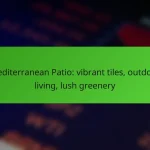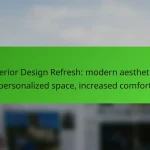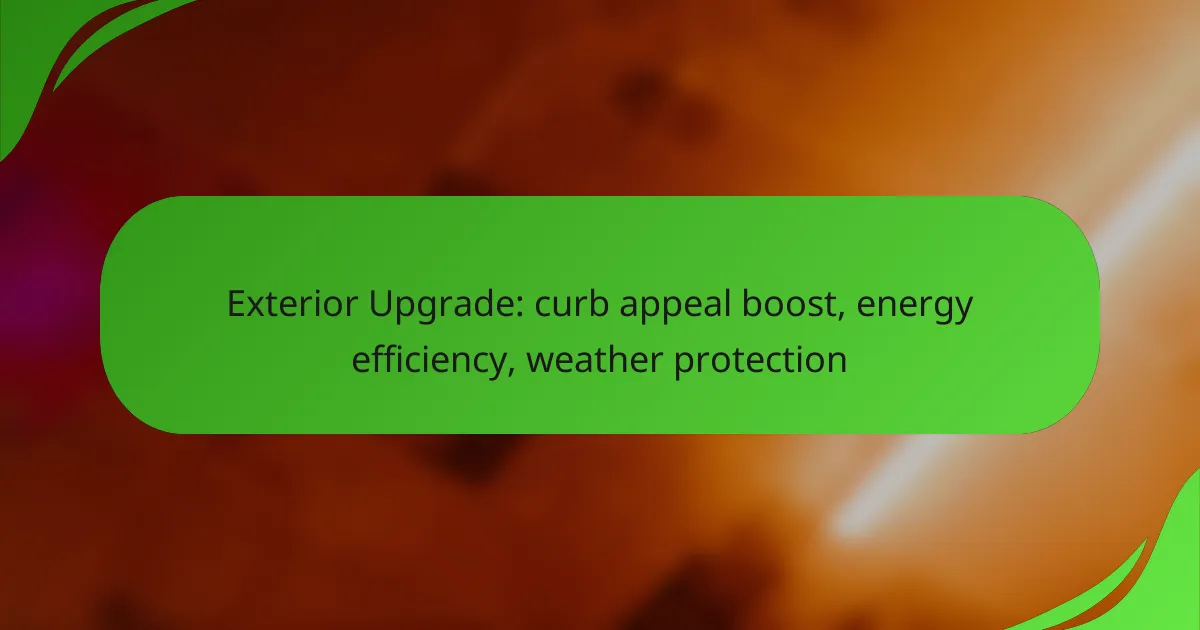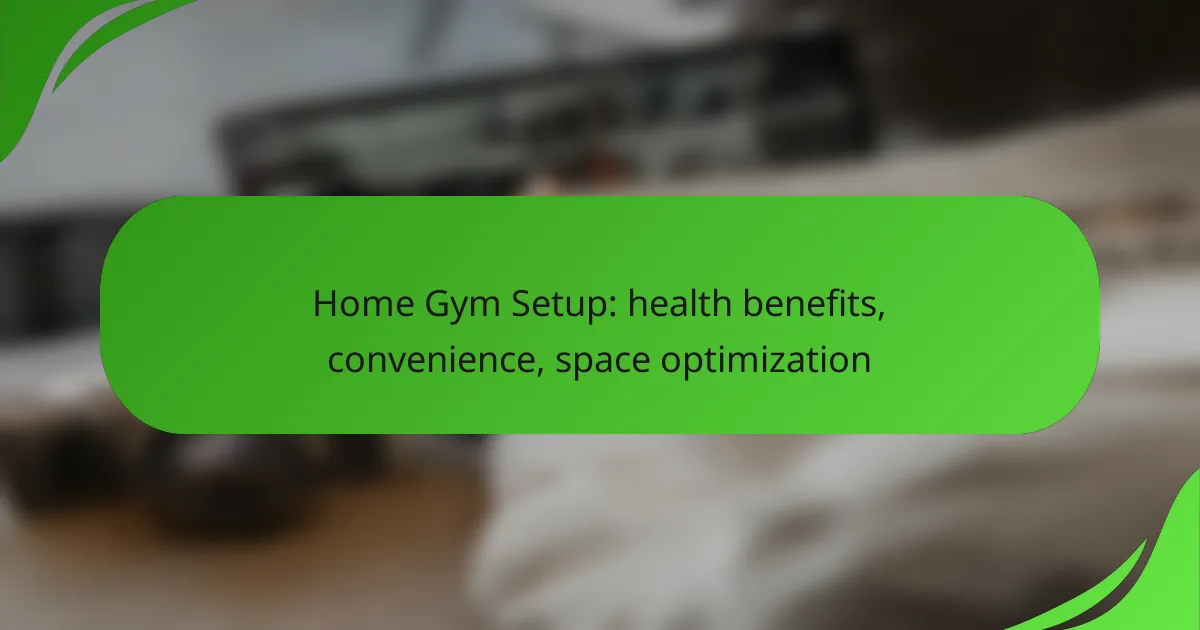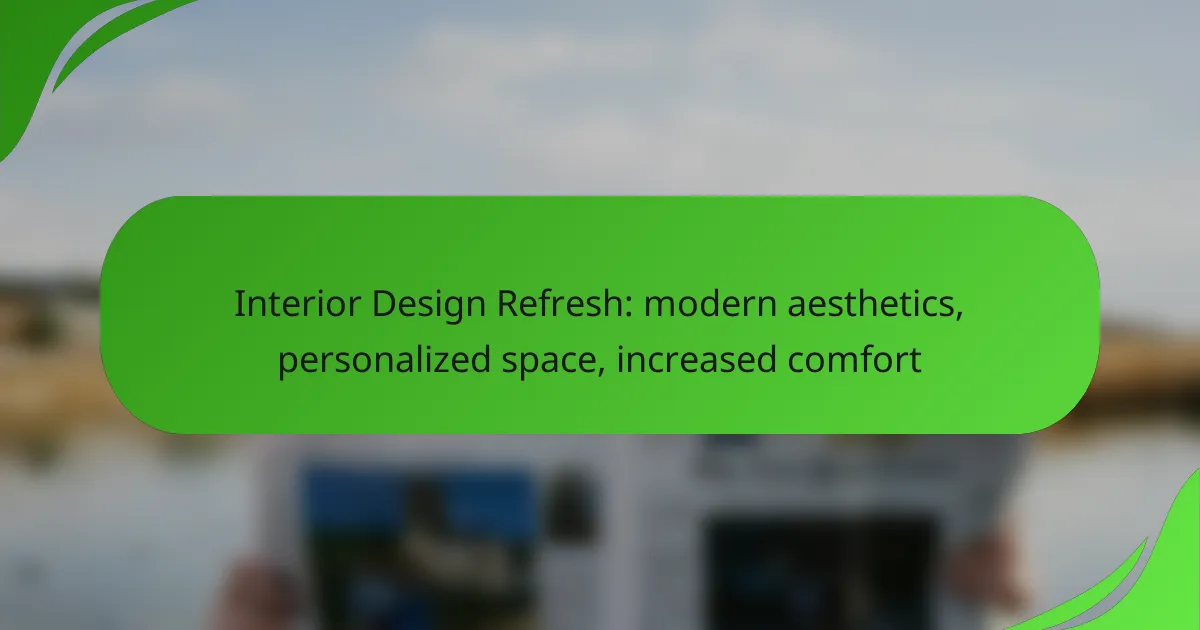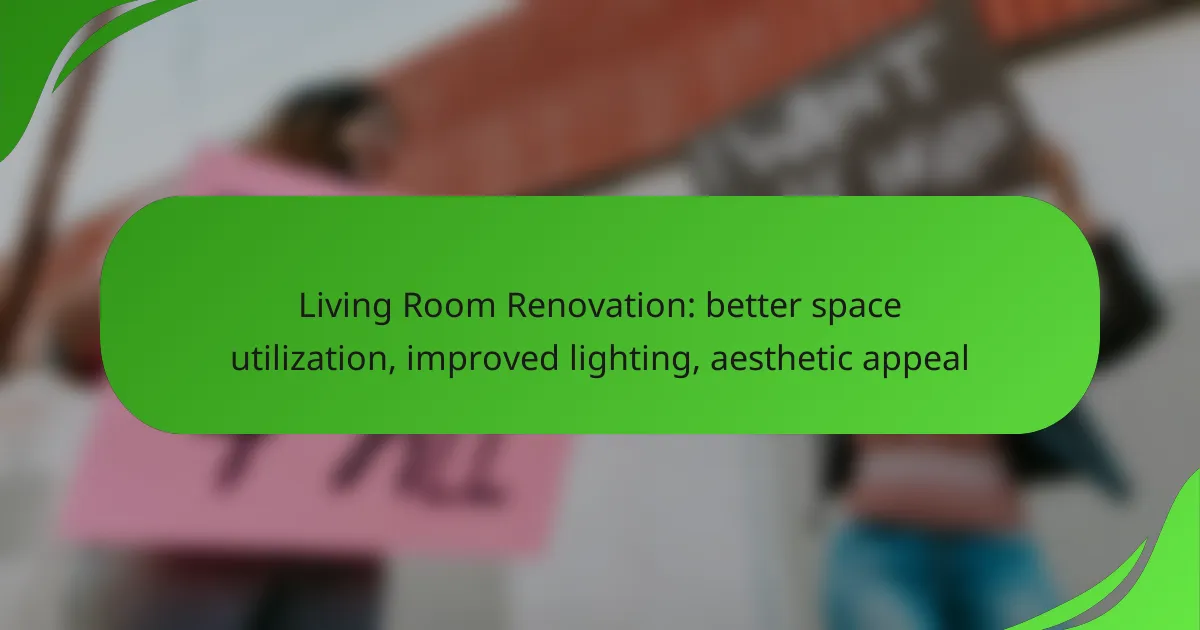Enhancing your home’s exterior can dramatically boost its curb appeal while also providing practical benefits like improved energy efficiency and weather protection. By investing in upgrades such as energy-efficient windows and durable materials, you not only create a more inviting appearance but also safeguard your home against the elements and reduce energy costs. These thoughtful improvements can transform your property into a more attractive and resilient space.

How can exterior upgrades enhance curb appeal in urban neighborhoods?
Exterior upgrades can significantly improve curb appeal in urban neighborhoods by making homes more visually appealing and inviting. These enhancements not only attract potential buyers but also contribute to energy efficiency and weather protection.
Fresh paint for doors and trim
A fresh coat of paint on doors and trim can dramatically elevate the appearance of a home. Opt for colors that complement the overall architecture and surrounding environment, as this can create a cohesive look that stands out.
When selecting paint, choose high-quality, weather-resistant options to ensure longevity. Consider using semi-gloss or gloss finishes for doors and trim, as they are easier to clean and maintain.
Landscaping with native plants
Incorporating native plants into landscaping can enhance curb appeal while promoting local biodiversity. Native plants typically require less water and maintenance, making them a sustainable choice for urban settings.
Choose plants that thrive in your local climate and soil conditions. Grouping plants by height and color can create visual interest and a more organized look, which is particularly appealing in densely populated areas.
Stylish outdoor lighting fixtures
Installing stylish outdoor lighting fixtures can improve both aesthetics and safety. Well-placed lighting highlights architectural features and pathways, making the home more inviting at night.
Consider energy-efficient LED fixtures that complement your home’s style. Options range from modern sconces to classic lanterns, allowing for personalization while also reducing energy costs.
New siding options like fiber cement
Upgrading to new siding materials, such as fiber cement, can enhance curb appeal and provide better weather protection. Fiber cement is durable, resistant to pests, and available in various styles and colors, making it a versatile choice for urban homes.
When selecting siding, consider factors like insulation properties and maintenance requirements. Investing in high-quality siding can lead to long-term savings on energy bills and upkeep.

What energy-efficient upgrades can improve home performance?
Energy-efficient upgrades can significantly enhance home performance by reducing energy consumption, lowering utility bills, and improving comfort. Key upgrades include installing energy-efficient windows, adding insulation, and upgrading HVAC systems.
Installing energy-efficient windows
Energy-efficient windows are designed to minimize heat loss and gain, which helps maintain a stable indoor temperature. Look for windows with a low U-factor and high Solar Heat Gain Coefficient (SHGC) to ensure optimal performance.
When selecting windows, consider double or triple glazing, low-emissivity (Low-E) coatings, and gas fills like argon or krypton for better insulation. While the initial investment may be higher, the long-term savings on energy bills can be substantial.
Adding insulation to exterior walls
Insulating exterior walls is crucial for reducing heat transfer and enhancing energy efficiency. Common insulation materials include fiberglass, foam board, and spray foam, each offering different R-values, which measure thermal resistance.
Before adding insulation, assess your current levels and identify areas that need improvement. Proper installation is key; ensure there are no gaps or compression that could undermine effectiveness. Investing in insulation can lead to noticeable reductions in heating and cooling costs.
Upgrading to a high-efficiency HVAC system
Upgrading to a high-efficiency HVAC system can dramatically improve home comfort and energy efficiency. Look for units with a high Seasonal Energy Efficiency Ratio (SEER) rating, which indicates better energy performance.
Consider systems that use variable-speed technology, as they adjust airflow based on demand, leading to lower energy usage. Regular maintenance, such as changing filters and scheduling annual check-ups, is essential to keep the system running efficiently and prolong its lifespan.
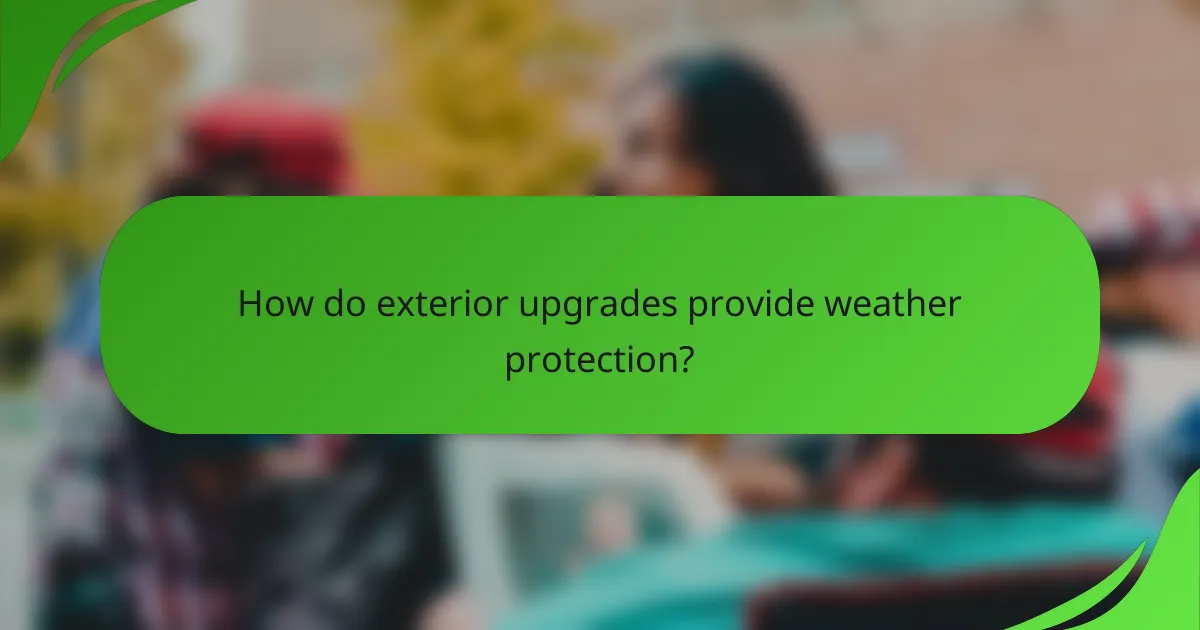
How do exterior upgrades provide weather protection?
Exterior upgrades enhance weather protection by using materials and techniques designed to withstand various environmental conditions. These improvements can significantly reduce the risk of damage from rain, wind, snow, and temperature fluctuations.
Durable roofing materials like metal
Metal roofing is a popular choice for weather protection due to its longevity and resistance to harsh elements. Unlike traditional shingles, metal roofs can last several decades and are less likely to crack or warp under extreme weather conditions.
When selecting metal roofing, consider options like galvanized steel or aluminum, which provide excellent durability. Ensure proper installation to maximize performance, as even the best materials can fail if not fitted correctly.
Weather-resistant siding options
Choosing weather-resistant siding can protect your home from moisture and pests. Materials such as fiber cement, vinyl, and treated wood are designed to withstand the elements while maintaining aesthetic appeal.
Fiber cement siding, for example, is resistant to rot, fire, and insects, making it a strong choice for various climates. Regular maintenance, such as painting or sealing, can further enhance the lifespan and effectiveness of your siding.
Sealing gaps and cracks for insulation
Sealing gaps and cracks around windows, doors, and other openings is crucial for maintaining energy efficiency and weather protection. Proper sealing prevents drafts and moisture intrusion, which can lead to mold growth and increased heating or cooling costs.
Use high-quality caulk or weatherstripping materials to fill gaps. Regularly inspect these areas, especially after severe weather, to ensure they remain effective. A simple check can save you money on energy bills and protect your home from damage.

What are the costs associated with exterior upgrades?
Exterior upgrades can vary significantly in cost depending on the type of project, materials used, and labor involved. Budgeting for these improvements is essential to enhance curb appeal, increase energy efficiency, and ensure weather protection.
Average costs for siding replacement
The cost of siding replacement typically ranges from USD 5,000 to USD 15,000, depending on the material chosen and the size of the home. Vinyl siding is generally the most affordable option, while wood or fiber cement can be more expensive but offer better durability and aesthetics.
When planning for siding replacement, consider additional expenses such as removal of old siding, insulation, and any necessary repairs to the underlying structure. Obtaining multiple quotes from contractors can help ensure competitive pricing.
Budgeting for landscaping projects
Landscaping projects can vary widely in cost, from a few hundred to several thousand USD, depending on the scope and complexity. Simple upgrades like planting shrubs or flowers may cost less, while hardscaping features such as patios or retaining walls can significantly increase expenses.
To effectively budget for landscaping, prioritize your goals and consider starting with smaller projects that can gradually enhance your outdoor space. Research local plants and materials that thrive in your climate to avoid costly replacements.
Cost of energy-efficient window installation
Installing energy-efficient windows can cost between USD 300 and USD 1,000 per window, depending on the type and brand. Double or triple-pane windows tend to be more expensive but offer better insulation and energy savings over time.
When considering window installation, factor in potential energy savings on heating and cooling bills, which can offset the initial investment. Look for windows that meet ENERGY STAR standards for optimal efficiency and check for any local rebates or incentives that may be available to reduce costs.

What factors should be considered when selecting upgrades?
When selecting upgrades for curb appeal, energy efficiency, and weather protection, consider local climate, neighborhood aesthetics, and any regulations that may apply. These factors will help ensure that your upgrades not only enhance your home’s appearance but also provide lasting benefits.
Local climate and weather patterns
Understanding your local climate is crucial when choosing upgrades. For instance, homes in areas with heavy rainfall may benefit from durable roofing materials and proper drainage systems, while those in sunny regions might prioritize energy-efficient windows to reduce cooling costs.
Consider the temperature extremes in your area as well. Insulation upgrades can significantly improve energy efficiency in both hot and cold climates, while weather-resistant siding can protect against harsh elements like wind and snow.
Neighborhood aesthetic and regulations
Neighborhood aesthetics play a significant role in determining the types of upgrades that will be well-received. Research the architectural styles prevalent in your area to ensure that your upgrades complement existing homes. For example, a modern design may not fit well in a historic neighborhood.
Additionally, check for any local regulations or homeowners’ association guidelines that may dictate specific materials, colors, or styles. Adhering to these rules can prevent costly modifications later and help maintain property values in your community.

How can homeowners maintain their exterior upgrades?
Homeowners can maintain their exterior upgrades by regularly inspecting and cleaning surfaces, ensuring that materials remain in good condition and function effectively. Consistent upkeep not only enhances curb appeal but also prolongs the life of the upgrades and improves energy efficiency.
Regular cleaning and inspections
Regular cleaning and inspections are essential for maintaining the integrity of exterior upgrades. Homeowners should schedule inspections at least twice a year, ideally in spring and fall, to check for signs of wear, damage, or dirt accumulation.
Cleaning should focus on surfaces like siding, windows, and roofing. Use a mild detergent and soft brush for siding and windows, while a pressure washer can effectively remove debris from driveways and patios. Avoid harsh chemicals that could damage materials.
During inspections, look for cracks, peeling paint, or rust, and address these issues promptly. Neglecting minor repairs can lead to more significant problems, increasing repair costs and compromising energy efficiency.
